Kashmir shawl
The Kashmir shawl is a type of shawl identified by its distinctive Kashmiri weave, and for being made of fine shahtoosh or pashmina wool. Contemporary variants include the pashmina and shahtoosh shawls (often mononymously referred to simply as the pashmina and shahtoosh). In the late 20th century, they evolved to middle-class popularity through generic cashmere products (rather than the higher-grade pashmina), and raffal, shawls woven in the Kashmiri style, but using thicker Merino wool. Originally designed as a covering for men in India, it has evolved in the popular cultures of India, Europe, and the United States as indicators of nobility and rank, heirlooms giving on a girl's coming-of-age and marriage, and subsequently, as artistic elements in interior design.
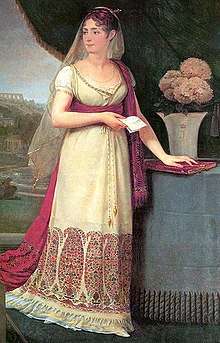 A portrait of Empress Joséphine wearing a Kashmir shawl and a gown made of Kashmir shawl fabric | |
| Type | Shawl |
|---|---|
| Material | Wool (shahtoosh, pashmina) |
| Place of origin | Kashmir |
Valued for its warmth, light weight and characteristic buta design, the Kashmir shawl trade inspired the global cashmere industry. The shawl evolved into its high-grade, sartorial use in the 13th century, and was used in the 16th century by Mughal and Iranian emperors, both personally and for honouring members of their durbar. In the late 18th century, it arrived in Britain, and then in France, where its use by Queen Victoria and Empress Joséphine popularised it as a symbol of exotic luxury and status. The Kashmir shawl has since become a toponym for the Kashmir region itself (cashmere, named after Kashmir), inspiring mass-produced imitation industries in India and Europe, and popularising the buta motif, today known as the Paisley motif after the factories in Paisley, Renfrewshire, Scotland that sought to replicate it.
Definition
The principal aspects of the shawl are its distinctive Kashmiri weaving technique and fine wool.[1] However, the Kashmir shawl's definition has varied in time and place, influenced by factors such as price, finery, purpose of wear, the intended wearer, constituent raw material, weaving technique, patterning present, and dyeing technique.[1] Today, shahtoosh shawls are no longer made because of a ban on the trade of products made from the Tibetan antelope.
The definition of the Kashmir shawl has differed in India and in the West. In India, the shawl was worn by men, with the fineness of the shawl indicating nobility or royal favour. In the West, depending on the fashion of the movement, the Kashmir shawl represented different types of commodities, originally worn by men, but thereafter by women, and then as decorative items in interior design. The definition has also been confused through fakery and imitation. Scholars, vendors and journalists have sometimes mistakenly used the words cashmere and pashmina synonymously,[1][2] or assumed that they are the same because they derive from the same animal. In reality, pashmina is a particularly fine form of cashmere, so all pashmina is cashmere, but not all cashmere is pashmina. In the late 19th century AD, weavers who had migrated to Punjab set up an imitation industry, applying the Kashmiri technique to Merino wool.[3] The resulting shawls were called raffal, and have also been classified by some as a species of Kashmir shawls, though the thicker wool means that they lack the distinctive lightness characteristic of the traditional Kashmir shawl.[3] More recently, in the late 1990s, western European and American sellers adopted the more exotic word pashmina to sell plain-weave shawls made from generic cashmere.[4] As a result, the associations with pashmina went from exclusive high fashion to middle-class popularity in 2000.[5][6]
Material
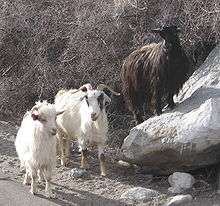
Kashmir shawls are traditionally made either of shahtoosh or pashmina.[1][7] Shahtoosh wool comes from the fine hairs on the underbelly of the Tibetan antelope.[7] Cashmere derives its name from the home of the Kashmir shawl, and is often incorrectly equated with pashmina. Pashmina and cashmere both come from the Changthangi goat, but pashmina is made from a fine subset of cashmere[2] ranging from 12-16 microns,[8] whereas generic cashmere ranges from 12-21 microns.[8]
| Type of wool | Diameter
(μm) |
|---|---|
| Shahtoosh | 10-12 |
| Pashmina | 12-16 |
| Cashmere | 12-21 |
| Merino wool | 18-24 |
Shahtoosh shawls are made from the hair of the Tibetan antelope, which averaging 7-10 microns in diameter, is the finest hair in the world.[1] These derived only from wild animals, grown during the harsh winters and rubbed off on rocks and shrubs in the summer, from where they were collected for weaving.[9] As the fineness of a shawl in India was traditionally seen as a mark of nobility,[7] they were historically reserved for members of the Mughal aristocracy. In the mid-eighteenth century, they became popular after their use by Queen Victoria of the United Kingdom and Empress Joséphine of France.[1] In Mughal times, they became known as "ring shawls", for being extremely light, and fine enough that a one metre by two metre shawl could be pulled whole through a finger ring.[9] They remain known this way today.[10] They today serve also as status symbol, valued on average between USD $2,000 and $3,000, but for up to $15,000.[10] Today, the export of shahtoosh shawls is banned under CITES,[8] and their production and sale banned under wildlife protection laws in India, China and Nepal.[8] Domestic laws in the US also prevent their sale.[8]
Design
Kani shawl
The standard design of Kashmir shawl is the Kani shawl, named after the Kanihama village where it was originally produced.[4][1] It is distinctive for using a variant of the "twill tapestry technique", referred to as such because of its similarity to European tapestry weaving techniques. However, it differs from tapestry weaving because the loom is horizontal instead of vertical, and its operation is closer to brocading.[9] In Kashmiri practice, this involved each weft going over two warps then under two warps. Using discontinuous wefts, it varied the west colour and created distinct colour areas identical on both faces of the fabric.[11] As a result, Kani shawls sported intricate designs, such as the buta.[1]
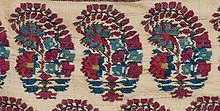
Paisley shawl
The Kashmir shawl is also closely associated with the Paisley shawl. The paisley design, originating in the buta, derives its name from the town of Paisley in Scotland, which became famous in the early 19th century for its imitation Kashmir shawls with the buta motif.[12] After 1850, many English speakers used to refer to any shawl with the buta design, Kashmiri or otherwise, as a Paisley shawl.[12]
History
The origins of the Kashmir shawl are a matter of historical debate. The earliest known mentions of an established shawl weaving industry date back to the 11th century AD.[1] The industry was probably older,[13] but some have suggested that Kashmir shawls were famous as far back as in the 3rd century BC, in Ashoka's reign.[14] In earlier times, shawls were used as a warm protective garment against cold weather.[1] By the 13th century, Kashmir's shawl industry was producing high-grade weaved fabric for sartorial purposes.[1] These shawls were marketed towards the ruling elite, and foreign markets.[1] In the 14th century AD, the industry was energised by the enthusiastic patronage of Sultan Zain-ul-Abidin of Kashmir.[1]
16th to 18th centuries
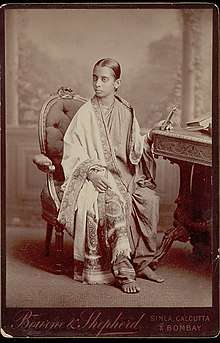
In 1526, Babur (1483-1530) founded the Mughal Empire in India, and established the practice of giving khil'at (or "robes of honour", typically made of expensive fabric) to members of their durbar to indicate high service, great achievement, or royal favour.[1] Under Babur, the Mughal khil'at was a set of clothes, which could include a turban, long coat, gown, fitted jacket, sash, shawl, trousers, shirt, and scarf.[4] One or all of these could be made of pashmina and embroidered in gold cloth.[4] In 1586, Kashmir was conquered by Babur's grandson Akbar.[4] In Akbar's time, a pair of Kashmir shawls were an expected part of khil'at ceremonies.[4] Akbar was also known for his love for shahtoosh shawls.[1] After conquering Kashmir, he introduced a requirement that they be woven into lengths long enough for the full body, spawning the jamawar shawl.[4] Until the rule of Shah Jahan (1592-1666), shahtoosh shawls were reserved for Mughal royalty, with only the more common pashmina shawls being gifted to nobility as khil'at.[4]
From the 16th to the early 20th centuries, the Safavid, Zand, and Qajar emperors of Iran also wore Kashmir shawl fabrics and gifted Kashmir shawls as khil'at within their political and religious practices.[4] In the Iranian elite, both men and women wore Kashmir shawl fabric as fitted clothes, rather than as a loose covering of the upper body.[4]
In the 17th and 18th centuries, political upheaval in Kashmir disrupted the shawl trade. Kashmir came under Afghan and subsequently Sikh rule.[4] In 1819, Ranjit Singh of Punjab conquered Kashmir.[4] In the 1840s, Ranjit Singh's court was lavishly decorated with Kashmir shawls and shawl cloth.[4] He also encouraged Kashmiri weavers to settle in Punjabi cities, and used Kashmir shawl cloth to pay allowances to his followers, to grant robes of honour, and to send gifts to other rulers, including the British.[4]
The Kashmir shawl in the Western world
The Kashmir shawl arrived in Europe towards the second half of the 18th century AD, by English and French individuals active in the Indian subcontinent.[1] These officials would gift Kashmir shawls to their wives and other high-status women.[1] Although these shawls later came to be worn exclusively by women,[1] they were originally worn exclusively by men, in line with the Indian practice.[4]
These shawls acquired near-mythical status following their patronage by Queen Victoria of the United Kingdom and Empress Joséphine of France, the latter of whom went on to own a collection of between three and four hundred Kashmir shawls.[15][1] Article 10 of the Treaty of Amritsar (1846), which constituted the princely state of Jammu and Kashmir, required the Maharaja of Kashmir Gulab Singh to send three pairs of Kashmiri shawls to the British government every year, to be given to Queen Victoria.[16] Even before becoming Empress of India, Queen Victoria adopted the Mughal practice of gifting shawls to visiting dignitaries.[12]
In 19th century England
In nineteenth-century English writing, despite the fact that shawls were worn by men, Kashmiri shawls became coded as women's luxuries. They acquired the status of heirlooms, worn by a girl on her marriage and coming-of-age,[7] and as heirlooms that women would inherit rather than purchase.[12] Their romantic but inaccurate associations with a "mysterious and unchanging East" were encouraged by popular journalism.
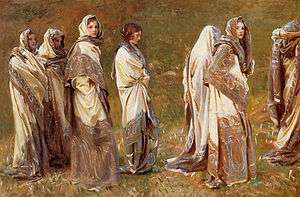
In 1852, Charles Dickens wrote in the magazine Household Words that "if an article of dress could be immutable, it would be the (Kashmir) shawl; designed for eternity in the unchanging East; copied from patterns which are the heirlooms of caste; and woven by fatalists, to be worn by adorers of the ancient garment, who resent the idea of the smallest change".[17][7] By the 1780s, there were imitation textile centres in Norwich, Edinburgh, and Lyon attempting to recreate the Kashmir shawl.[1] By the 19th century, the original Kashmir shawl (and to some extent the European imitations) were a fashion staple for Western high society.[1] Over time, the shawls began to be seen as a ritual casting off for the European man returning from India, restoring himself to England and Englishness by handing to a woman a garment commonly understood in India to be worn by men.[12] As a result, although the shawls were a status symbol for men in India, they were exclusively worn by aristocratic women in Europe.[1] In Vanity Fair, Jos Sedley returns from Bengal with a "white Cashmere shawl", an indication that it was an original, as imitations were generally patterned.[12] Patterned shawls could take up to 18 months to make and were therefore more likely to be worn by nobility than the prosperous middle class.[12]
Kashmir shawls came to evoke fairytale status and marriage for bourgeois women. In Elizabeth Gaskell's 1854 novel North and South, Margaret, the heroine, modelled a Kashmir shawl, with Gaskell describing the shawl as having a "spicy Eastern smell", "soft feel", and "brilliant colour".[18] When Margaret met her future husband, Gaskell described her attire as completed by "a large Indian shawl which hung about her in heavy folds and which she wore as an empress wears her drapery".[19]
As heirlooms, Kashmir shawls also came to be seen as items of great value. Since English law restricted women's abilities to inherit land, the Kashmir shawl served as an item of high exchange value that a woman could carry.
In 19th century France
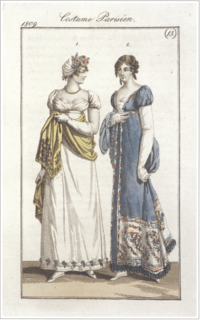
The Kashmir first appeared in French fashion magazines and portraits in 1790, but only arrived in significant quantities after the French campaign in Egypt and Syria (1798-1801). When initially presented with them Empress Joséphine wrote to her son Eugène, "I find them hideous. Their great advantage lies in their lightness, but I doubt very much if they will ever become fashionable."[15] However, she changed her mind quickly and went on to own a collection of between three and four hundred shawls, some made of lace, gauze and muslin, but most being Kashmiri shawls.[15] French magazines were attentive to her dress styles and reinterpreted in fashion plates, giving the shawl widespread influence.[15] Through her enthusiastic example, the Kashmir shawl gained status as a fashion icon in Paris.[15] The cashmere shawls suited the French well, providing the needed warmth, while adding visual interest to white French gowns through the traditional teardrop buta pattern and discreet floral motifs.[15] It became a symbol of French bourgeois status from the Bourbon Restoration (1815-48) through the Second French Empire (1852-70).[4] As a class marker, they fulfilled 19th century French tastes because they looked rich, had extensive ornamentation, artistic qualities, and were made of expensive raw materials.[4] Just as in England, they acquired the status of wedding gifts.[4] Unmarried women were discouraged from wearing Kashmir shawls because doing so would "lead people to believe that they are possessed of an unbridled love of luxury and deprive themselves of the pleasure of receiving such finery from a husband".[4]
In 19th century America
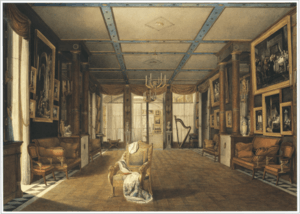
Around the time the Kashmir shawl became fashionable in Britain, Euro-American women on the northeastern coast of the United States began wearing them.[4] Shawl fashion in the United States followed western European fashion trends. Shawls were popular holiday presents throughout the 1860s, and Indian shawls were considered wise purchases in 1870. By the end of the 1870s, however, imitation shawls began to eclipse the genuine Indian shawls in advertisements. Between the 1880s and World War I (1914-1918), wealthy European and Euro-American women began using Kashmir shawls as decorative pieces on pianos instead of on themselves.
Influences
The paisley design, originating in the Indian buta, derives its name from Paisley, Scotland, where imitation shawls were manufactured.[12] In French, the word cachemire refers to the paisley's teardrop-shape itself, because of the close links between the pattern and the material.[12] A talcum powder named "Cashmere Bouquet" is still sold by an American mail order business which specializes in commodity nostalgia, with an advertisement situating the product in the 1870s.[4] Over time, repeated European and Euro-American usage disassociated the word "cashmere" from its geographical origin and may have weakened its link to the "exotic".[4] China and Mongolia have become geographical references for cashmere sweaters in thirty-eight U.S. mail order catalogs such as Lands' End.[4]
References
| Wikimedia Commons has media related to Cashmere wool shawls. |
- Skarratt, Ben (August 2018). "From India to Europe: The Production of the Kashmir Shawl and the Spread of the Paisley Motif" (PDF). Global History of Capitalism Project.
- Silk, mohair, cashmere and other luxury fibres. Franck, Robert R., Textile Institute (Manchester, England). Boca Raton, FL: CRC Press. 2001. ISBN 1-59124-772-1. OCLC 57250698.CS1 maint: others (link)
- Hāṇḍā, Omacanda, 1936- (1998). Textiles, costumes, and ornaments of the western Himalaya. New Delhi: Indus Pub. Co. ISBN 81-7387-076-4. OCLC 1008525135.
It were those fugitive Kashmiri weavers, who introduced Kashmiri technique, art of weaving and needle-work in Chamba and Nurpur area of Himachal Pradesh which, under the native traditional influences, developed into hybrid versions. At other places in the Punjab plains, the degenerated form of the Kashmiri embroidered woollen shawls of raffal - a mill-yarn made from the marino wool-tops, still continue to be manufactured and sold off as the genuine Kashmiri product.
CS1 maint: multiple names: authors list (link) - Maskiell, Michelle (Spring 2002). "Consuming Kashmir: Shawls and Empires, 1500-2000". Journal of World History. University of Hawai'i Press (on behalf of World History Association). 13 (1): 27–65. doi:10.1353/jwh.2002.0019. JSTOR 20078943.
- "Pushing Pashmina: Securing a Wrap". Wall Street Journal. 1999-11-06. ISSN 0099-9660. Retrieved 2020-03-27.
- Safire, William (2000-01-16). "The Way We Live Now: 1-16-00: On Language; Pashmina". The New York Times. ISSN 0362-4331. Retrieved 2020-03-27.
- Irwin, John, 1917-1997. (1973). The kashmir shawl. London: H.M. Stationery Off. ISBN 0-11-290164-6. OCLC 3241655.CS1 maint: multiple names: authors list (link)
- "Identification Guidelines for Shahtoosh and Pashmina" (PDF). US Fish and Wildlife Service: National Fish and Wildlife Forensics Laboratory, Ashland, Oregon. 2002. Archived (PDF) from the original on 27 March 2020. Retrieved 27 March 2020.
- Irwin, John, 1917-1997. (1973). The Kashmir shawl. London: H.M. Stationery Off. ISBN 0-11-290164-6. OCLC 3241655.
Although a garment so simple in shape and form undoubtedly has a long history in the Near East,3 the finest shawls of the modern era are synonymous with the name of Kashmir.
CS1 maint: multiple names: authors list (link) - Colacello, Bob. "O.K., Lady, Drop the Shawl". Vanity Fair. Retrieved 2020-03-26.
- Emery, Irene. (1994). The primary structures of fabrics : an illustrated classification. London: Thames and Hudson. ISBN 0-500-01623-2. OCLC 31607600.
‘discontinuous wefts to vary the weft colour and create distinct colour areas that are identical on the two faces of the fabric’
- Daly, Suzanne. (2011). The empire inside : Indian commodities in Victorian domestic novels. Ann Arbor: University of Michigan Press. ISBN 978-0-472-07134-0. OCLC 617509005.
- Moti, Chandra (1954). Bulletin of the Prince of Wales Museum of Western India. Bombay: the Trustees. p. 7.
- Brar, Prabhdip (2014). "The Rungs in the Making of the Indigenous Shawl from Kashmir". Contemporary Issues and Trends in Fashion, Retail and Management. Hyderabad: National Institute of Fashion Technology. pp. 509–515. ISBN 978-81-7800-297-2.
- Joséphine and the arts of the Empire. DeLorme, Eleanor P., Chevallier, Bernard, 1943-, J. Paul Getty Museum. Los Angeles: J.P. Getty Museum. 2005. p. 167. ISBN 0-89236-801-2. OCLC 57432294.CS1 maint: others (link)
- Treaty of Amritsar.
- Dickens, Charles (1852). "Shawls". Household Words. 5 (127): 552–556.
- Gaskell, Elizabeth Cleghorn, 1810-1865. (5 May 2010). North and south. London. p. 39. ISBN 978-1-4070-9088-7. OCLC 881282240.CS1 maint: multiple names: authors list (link)
- Gaskell, Elizabeth Cleghorn, 1810-1865. (5 May 2010). North and south. London. p. 99. ISBN 978-1-4070-9088-7. OCLC 881282240.CS1 maint: multiple names: authors list (link)